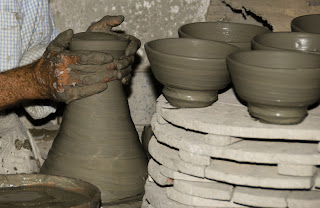What materials are made from vegetables?
CURRAN
1. What is the origin of the material
CURRAN is a carrot-based material
2. What are the methods of refining the material
It is manufactured using a top-secret method that has been five years in the making. Nano fibers found in carrots are extracted and combined with high tech resins enabling tough, durable components to be molded to whatever shape, degree of stiffness, strength or lightness required. The strong nano-fibers from this carrot "soup" are then extracted so that they can be processed in a variety of ways.
Most of the water is removed and hi-tech resins are added to the mix. This mixture can then be molded and heated to make a strong material.
3. What are the environmental impacts of the material
No harmful impact
4. What are the sustainable aspects of the material
Around 30% of carrots get rejected, and local producers supply the company, CelluComp Ltd, with this secondary source not used for human consumption.
5. What are the range of objects that are made from the material
Currently the company makes fishing rods using this material. They also plan on making snowboards and car parts, and even battleships.
(http://www.carrotmuseum.co.uk/curran.html)
Jute
1. What is the origin of the material
Jute is a long, soft, shiny vegetable fiber that can be spun into coarse, strong threads. The jute fiber comes from the stem and ribbon (outer skin) of the jute plant.
2. What are the methods of refining the material
The fibers are first extracted by retting. Then stripping begins: non-fibrous matter is scraped off, then the workers dig in and grab the fibers from within the jute stem.
3. What are the environmental impacts of the material
4. What are the sustainable aspects of the material
Jute fiber is 100% bio-degradable and recyclable and thus environmentally friendly and sustainable.
5. What are the range of objects that are made from the material
Industrial yarn, fabric, net, and sacks, floor coverings, carpet, backing cloth (CBC), and canvas. It is also used for making fashion & promotional bags.
What materials are made from Animals?
LEATHER
1. What is the origin of the material
Leather is a durable and flexible material created via the tanning of animal rawhide and skin, primarily cattlehide.
2. What are the methods of refining the material
It can be produced through different manufacturing processes, ranging from cottage industry to heavy industry. The leather manufacturing process is divided into three fundamental sub-processes: preparatory stages, tanning, and crusting.
3. What are the environmental impacts of the material
Leather is a product with high environmental impact, most notably due to:
▪ the impact of livestock
▪ the heavy use of polluting chemicals in the tanning process
▪ air pollution due to the transformation process
Leather biodegrades slowly; it takes 25–40 years to decompose.
4. What are the sustainable aspects of the material
Cow leather is a bi-product of the beef industry, the vegetable-tanned variety is the most sustainable one.
5. What are the range of objects that are made from the material
Clothes, shoes, handbags, furniture, etc.
WOOL
1. What is the origin of the material
Wool is the textile fiber obtained from sheep and certain other animals.
2. What are the methods of refining the material
Sheep shearing is the process by which the woollen fleece of a sheep is cut off. Then it gets washed.
3. What are the environmental impacts of the material
Wool is an animal protein, and as such it can be used as a soil fertilizer, being a slow release source of nitrogen and ready made amino acids.
4. What are the sustainable aspects of the material
Each sheep produces large amount of wool over the lifetime. Wool can also be recycled by cutting or tearing apart existing wool fabric and respinning the resulting fibers.
5. What are the range of objects that are made from the material
In addition to clothing, wool has been used for blankets, horse rugs, carpeting, felt, etc.
What materials are made from Minerals?
CLAY
1. What is the origin of the material
Clay is a naturally occurring aluminum silicate composed primarily of fine-grained minerals
2. What are the methods of refining the material
Clay is excavated from the deposit site.
3.What are the environmental impacts of the material
No impact
4. What are the sustainable aspects of the material
Clay is naturally-occurring geologic sustainable material.
5. What are the range of objects that are made from the material
Bricks, cooking pots, art objects, dish ware, etc.
(http://en.wikipedia.org/wiki/Clay)
SAND
1. What is the origin of the material
Sand is a naturally occurring granular material composed of finely divided rock and mineral particles.
2. What are the methods of refining the material
The raw material undergoes intensive, repetitive routines of screen sizing, washing, and classifying until a stockpile of the desired sand grain size has been extracted from the “raw sand”. It is then dehydrated and dried to obtain the final product.
3. What are the environmental impacts of the material
4. What are the sustainable aspects of the material
Sand mining is a direct and obvious cause of erosion, and also impacts the local wildlife.
Sand's many uses require a significant dredging industry, raising environmental concerns over fish depletion, landslides, and flooding.
Sand can be recycled.
Sand can be recycled.
5. What are the range of objects that are made from the material
Glass: Sand is the principal component in common glass. Used in Water filtration, Sandbags, Brick, etc.


















No comments:
Post a Comment